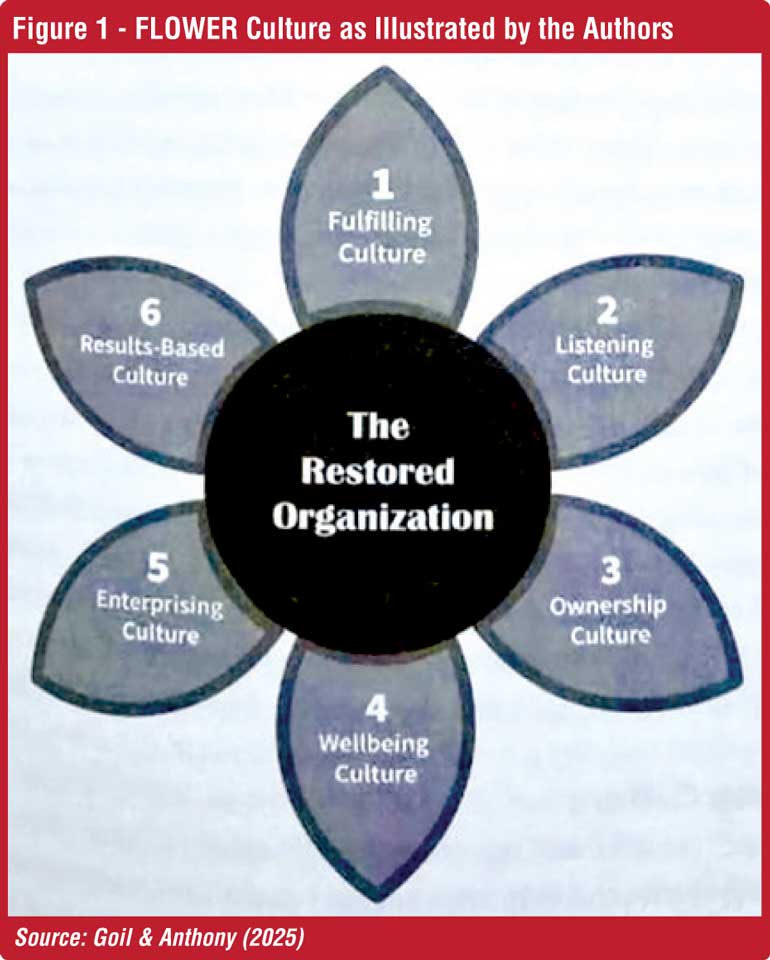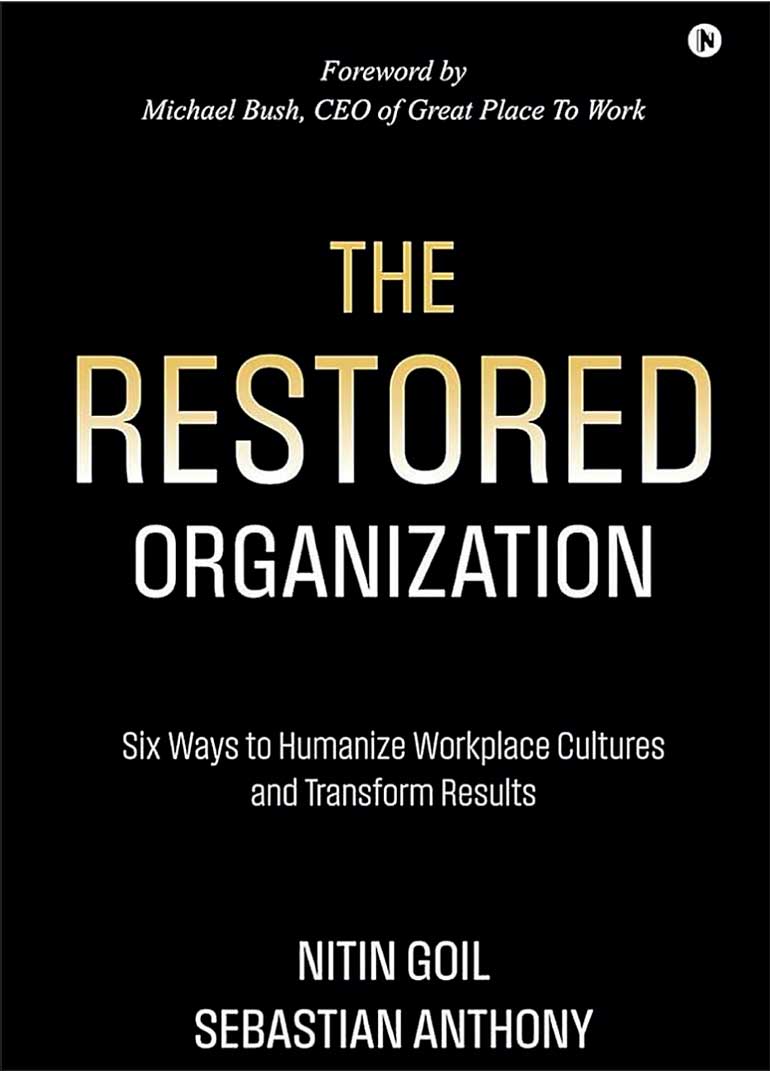Monday Dec 15, 2025
Monday Dec 15, 2025
Tuesday, 28 October 2025 00:18 - - {{hitsCtrl.values.hits}}


 I enjoyed reading “Restored Organization”, a book that describes ways to “humanise” workplace cultures and transform results. I met the two authors during the Great Place to Work (GPW) Regional Conference held in Colombo recently, and enjoyed the session conducted by Nitin Goil on the same theme. Today’s column is a reflection on the contents of it in connecting with Sri Lankan context.
I enjoyed reading “Restored Organization”, a book that describes ways to “humanise” workplace cultures and transform results. I met the two authors during the Great Place to Work (GPW) Regional Conference held in Colombo recently, and enjoyed the session conducted by Nitin Goil on the same theme. Today’s column is a reflection on the contents of it in connecting with Sri Lankan context.
Overview
“The Restored Organization” written by Nitin Goil and Sebastian Anthony provides practical advice on how to lead with empathy and vision to build a thriving workplace culture. It highlights the philosophy for transforming a dysfunctional or toxic workplace into one where employees feel valued, supported, and motivated. The authors emphasise the importance of empathy, inclusion, and ongoing adaptation to create a positive culture that drives innovation and engagement.
They candidly share that the book was inspired by their personal experiences with toxic workplace environments and highlights the staggering cost of employee disengagement. Nitin is a global leadership advisor with more than 25 years of experience working with senior leaders in the USA and Asia. His expertise is in the area of culture transformation, talent development and employee engagement. Sebastian has over 30 years of experience working in learning and organisational development in three major industries, healthcare, hospitality and consulting. The collective wisdom of both of them is amply shown in the book.
As stated in the book, according to Gallup’s 2024 State of the Global Workplace, 62% of employees are disengaged from work, costing the global economy $ 8.9 trillion in productivity losses. The engagement referred here is simply the physical, mental and emotional involvement of an employee towards one’s job.
As the authors observe, organisations today are dealing with a polarity challenge of driving business results while being human-centred and keeping employees engaged. They must deal with demanding shareholders who are looking for quick growth and results, while managing employees’ expectations. This constant push and pull leads to employees feeling disengaged and demotivated, creating a culture of distrust and avoidance.
Restoration in high demand
In writing the Foreword, Michael Bush, CEO of Great Place to Work highlights how this book underscores the critical importance of workplace culture in today’s evolving, post-pandemic business landscape. As he observe, the book emphasises that a positive culture is not a one-time initiative but requires ongoing attention, self-reflection, and adaptability.
“The book offers practical strategies for leaders to build inclusive, high-performing workplace” states he. “It positions culture as a continuous, strategic driver of innovation, engagement, and sustainable success. Ultimately, The Restored Organization serves as both a resource and a call to action, urging leaders to make culture an integral part of their strategy, ensuring organisations empower and support people while achieving strong business results. This makes it an essential guide for anyone shaping the future of work.”
Organisational culture is simply the “way we do things here”. In a broader sense, is the shared set of values, beliefs, norms, and behaviours that shape how employees in an organisation interact, make decisions, and approach their work.
The book introduces the term “culture restoration” as a way of re-kindling the human spirit, which might have fragmented by disorder and disharmony. It requires more than just a broad, one-size-fits-all solution. It demands a clear and intentional focus, involving interventions that identify those toxic pockets and tackle them head-on.
As the authors suggest, the goal should be to create an organisation where every action and behaviour, from top leadership to frontline operations, is connected and aligned with the organisation’s core values and strategy. When culture that has been thoughtfully rebuilt with trust, empathy, and inclusion, the organisation flourishes with people and results thriving together.
Trust: The book highlights that the trust is at the core of any restored organisation. It is the invisible thread that holds everything together, the element that gives employees the confidence to speak openly, collaborate freely, and feel safe in their roles. Without trust, the culture of an organisation can quickly become toxic. “Reflecting on our experiences, when we encountered a workplace lacking trust, the atmosphere was noticeably tense; People started to hold back, afraid to express their ideas or concerns because of fear- fear of judgment, fear of retribution, or fear of making mistakes”, observe the authors.
Empathy: At the heart of a restored organisation, you find empathy, creating an environment where everyone feels truly valued and understood. According to the book, when empathy is absent, people often feel isolated and unsupported, motivation plummets, and one does not feel safe to speak up. Restoring empathy is essential to healing this kind of damage. When empathy becomes a guiding principle in an organisation, it transforms how people communicate and work together. As authors observe, when empathy starts to take root, the walls created by toxic behaviours begin to crumble, replaced by a supportive, restored environment where people are motivated to contribute.
Inclusion: Inclusion in a restored organisation works hand in hand with empathy. The book highlights that while empathy helps us understand each person better, inclusion ensures that every person, regardless of background, feels seen, heard, and valued. It is about creating an environment where diverse voices can contribute meaningfully, and decisions reflect a broad range of perspectives. When an organisation embraces inclusion and encourages all voices to be heard, it creates a culture of belonging. Employees feel respected and empowered, knowing their perspectives matter.
In connecting trust, empathy and inclusion, the authors introduce a flagship concept effectively, viz. FLOWER culture.
FLOWER culture at a glance
“Through conversations and in-depth interactions with over 100 leaders globally, we began to understand the complexities of organisational culture and noticing patterns that were similar”, state the authors. They compare restoring an organisation’s culture to the petals of a flower. They copyrighted framework of FLOWER, offers a holistic framework and a path to restoration. It allows organisations to create a roadmap that can help them drive sustainable, long-term change. Let us reflect on six petals showcased by the authors. Figure 1 contains the details.
It is worthwhile reflecting on the six petals, keeping our organisations in mind.
Fulfilling Culture: As the authors describe, a fulfilling culture is what makes employees feel that their work has meaning, that they are valued, and they are contributing to something larger than themselves. Without it, employees often find themselves trapped in a cycle of disengagement. The book highlights three elements essential for building a fulfilling culture, viz. purpose, recognition, and career development. The real case shown as an example is Patagonia, an outdoor apparel brand, with the purpose, “We are in business to save our home planet.”
Listening Culture: This is the second petal of the FLOWER framework. It involves creating a space where every voice is heard and valued, and feedback is truly integrated into how the organisation operates. As the authors observe, when a listening culture is missing, it is easy for employees to feel alienated. The book highlights three elements essential for building a listening culture, viz, active listening, open feedback channels, and commitment to inclusion. The real case shown as an example is Netflix, where the organisational culture is deliberately structured to prioritise active listening, with the emphasis on honesty.
Ownership Culture: According to authors, this is the petal that encourages people to take initiative, contribute meaningfully, and invest fully in the organisation’s success. The book highlights three elements essential for building an ownership culture, viz. empowerment, shared goals, and transparent communication. The real case shown as an example is Yara International, a Norwegian chemical organization, where the above three elements are vibrantly visible.
Well-being Culture: As the authors observe, a culture of well-being goes far beyond offering quick fixes like fitness resources or health incentives. True well-being is where certified international specialist (CIS) highlights three elements essential for building a well-being culture, viz, holistic programs, work-life integration, and supportive environment. The real case shown as an example is Johnson & Johnson, where its Human Performance institute (HPI) has pioneered innovative practices that refine how an organisation should approach its people well-being.
Enterprising Culture: The focus of this petal is on innovation, risk taking, and adaptability. When employees know they have the freedom to try new approaches, it sparks creativity and helps them feel more connected to their work. The book highlights three elements essential for building an enterprising culture, viz, innovation incentives, collaborative spaces, and continuous learning. The real case shown as an example is DHL Express, a global leader in logistics and express delivery, where innovation awards, and Certified International Specialist (CIS) program feature prominently.
Results-based Culture: The final petal of the framework is about creating clarity and accountability around specific, measurable outcomes. As authors observes, in such cultures, employees know what is expected of them, and their efforts are aligned with the organisation’s larger goals. Three elements essential for building a results-based culture are accountability systems, clear performance metrics, and performance reviews. The real case shown as an example is BHP, a leading mining firm based in Australia, with a “code of conduct” providing a strong foundation for ethical behaviour and operational integrity.
The expectation is the collective contribution consisting of all six petals to make the “flower to blossom.”
Way forward
Sri Lankan organisations might be having some of the petals firm and some other petals fragile. A deep reflection is needed to balance results with relationships to ensure enterprise achievements and employee aspirations. “If everyone is moving forward together, then success takes care of itself,” so said Henry Ford. I would recommend the “Restored Organization” to read, reflect, and relate towards revived results.
(The writer, a Senior Professor in Management, and an Independent Non-executive Director, can be reached at [email protected], [email protected] or www.ajanthadharmasiri.info.)